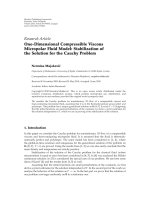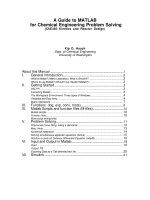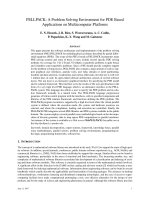Problem Solving Basics for One Dimensional Kinematics
Bạn đang xem bản rút gọn của tài liệu. Xem và tải ngay bản đầy đủ của tài liệu tại đây (450.41 KB, 5 trang )
Problem-Solving Basics for One-Dimensional Kinematics
Problem-Solving Basics for
One-Dimensional Kinematics
Bởi:
OpenStaxCollege
Problem-solving skills are essential to your success in Physics. (credit: scui3asteveo, Flickr)
Problem-solving skills are obviously essential to success in a quantitative course in
physics. More importantly, the ability to apply broad physical principles, usually
represented by equations, to specific situations is a very powerful form of knowledge. It
is much more powerful than memorizing a list of facts. Analytical skills and problemsolving abilities can be applied to new situations, whereas a list of facts cannot be
made long enough to contain every possible circumstance. Such analytical skills are
useful both for solving problems in this text and for applying physics in everyday and
professional life.
Problem-Solving Steps
While there is no simple step-by-step method that works for every problem, the
following general procedures facilitate problem solving and make it more meaningful.
A certain amount of creativity and insight is required as well.
Step 1
Examine the situation to determine which physical principles are involved. It often
helps to draw a simple sketch at the outset. You will also need to decide which
1/5
Problem-Solving Basics for One-Dimensional Kinematics
direction is positive and note that on your sketch. Once you have identified the physical
principles, it is much easier to find and apply the equations representing those principles.
Although finding the correct equation is essential, keep in mind that equations represent
physical principles, laws of nature, and relationships among physical quantities. Without
a conceptual understanding of a problem, a numerical solution is meaningless.
Step 2
Make a list of what is given or can be inferred from the problem as stated (identify
the knowns). Many problems are stated very succinctly and require some inspection
to determine what is known. A sketch can also be very useful at this point. Formally
identifying the knowns is of particular importance in applying physics to real-world
situations. Remember, “stopped” means velocity is zero, and we often can take initial
time and position as zero.
Step 3
Identify exactly what needs to be determined in the problem (identify the unknowns).
In complex problems, especially, it is not always obvious what needs to be found or in
what sequence. Making a list can help.
Step 4
Find an equation or set of equations that can help you solve the problem. Your list of
knowns and unknowns can help here. It is easiest if you can find equations that contain
only one unknown—that is, all of the other variables are known, so you can easily solve
for the unknown. If the equation contains more than one unknown, then an additional
equation is needed to solve the problem. In some problems, several unknowns must be
determined to get at the one needed most. In such problems it is especially important to
keep physical principles in mind to avoid going astray in a sea of equations. You may
have to use two (or more) different equations to get the final answer.
Step 5
Substitute the knowns along with their units into the appropriate equation, and obtain
numerical solutions complete with units. This step produces the numerical answer; it
also provides a check on units that can help you find errors. If the units of the answer
are incorrect, then an error has been made. However, be warned that correct units do not
guarantee that the numerical part of the answer is also correct.
2/5
Problem-Solving Basics for One-Dimensional Kinematics
Step 6
Check the answer to see if it is reasonable: Does it make sense? This final step is
extremely important—the goal of physics is to accurately describe nature. To see if the
answer is reasonable, check both its magnitude and its sign, in addition to its units.
Your judgment will improve as you solve more and more physics problems, and it will
become possible for you to make finer and finer judgments regarding whether nature is
adequately described by the answer to a problem. This step brings the problem back to
its conceptual meaning. If you can judge whether the answer is reasonable, you have a
deeper understanding of physics than just being able to mechanically solve a problem.
When solving problems, we often perform these steps in different order, and we also
tend to do several steps simultaneously. There is no rigid procedure that will work every
time. Creativity and insight grow with experience, and the basics of problem solving
become almost automatic. One way to get practice is to work out the text’s examples for
yourself as you read. Another is to work as many end-of-section problems as possible,
starting with the easiest to build confidence and progressing to the more difficult. Once
you become involved in physics, you will see it all around you, and you can begin to
apply it to situations you encounter outside the classroom, just as is done in many of the
applications in this text.
Unreasonable Results
Physics must describe nature accurately. Some problems have results that are
unreasonable because one premise is unreasonable or because certain premises are
inconsistent with one another. The physical principle applied correctly then produces an
unreasonable result. For example, if a person starting a foot race accelerates at 0.40 m/s2
for 100 s, his final speed will be 40 m/s (about 150 km/h)—clearly unreasonable because
the time of 100 s is an unreasonable premise. The physics is correct in a sense, but
there is more to describing nature than just manipulating equations correctly. Checking
the result of a problem to see if it is reasonable does more than help uncover errors in
problem solving—it also builds intuition in judging whether nature is being accurately
described.
Use the following strategies to determine whether an answer is reasonable and, if it is
not, to determine what is the cause.
Step 1
Solve the problem using strategies as outlined and in the format followed in the worked
examples in the text. In the example given in the preceding paragraph, you would
identify the givens as the acceleration and time and use the equation below to find the
unknown final velocity. That is,
3/5
Problem-Solving Basics for One-Dimensional Kinematics
v = v0 + at = 0 + (0.40 m/s2)(100 s) = 40 m/s.
Step 2
Check to see if the answer is reasonable. Is it too large or too small, or does it have the
wrong sign, improper units, …? In this case, you may need to convert meters per second
into a more familiar unit, such as miles per hour.
1 mi
60 s 60 min
( 40sm )( 3.28m ft )( 5280
ft )( min )( 1 h ) = 89 mph
This velocity is about four times greater than a person can run—so it is too large.
Step 3
If the answer is unreasonable, look for what specifically could cause the identified
difficulty. In the example of the runner, there are only two assumptions that are suspect.
The acceleration could be too great or the time too long. First look at the acceleration
and think about what the number means. If someone accelerates at 0.40 m/s2, their
velocity is increasing by 0.4 m/s each second. Does this seem reasonable? If so, the
time must be too long. It is not possible for someone to accelerate at a constant rate of
0.40 m/s2 for 100 s (almost two minutes).
Section Summary
• The six basic problem solving steps for physics are:
Step 1. Examine the situation to determine which physical principles are
involved.
Step 2. Make a list of what is given or can be inferred from the problem as stated
(identify the knowns).
Step 3. Identify exactly what needs to be determined in the problem (identify the
unknowns).
Step 4. Find an equation or set of equations that can help you solve the problem.
Step 5. Substitute the knowns along with their units into the appropriate
equation, and obtain numerical solutions complete with units.
Step 6. Check the answer to see if it is reasonable: Does it make sense?
4/5
Problem-Solving Basics for One-Dimensional Kinematics
Conceptual Questions
What information do you need in order to choose which equation or equations to use to
solve a problem? Explain.
What is the last thing you should do when solving a problem? Explain.
5/5









